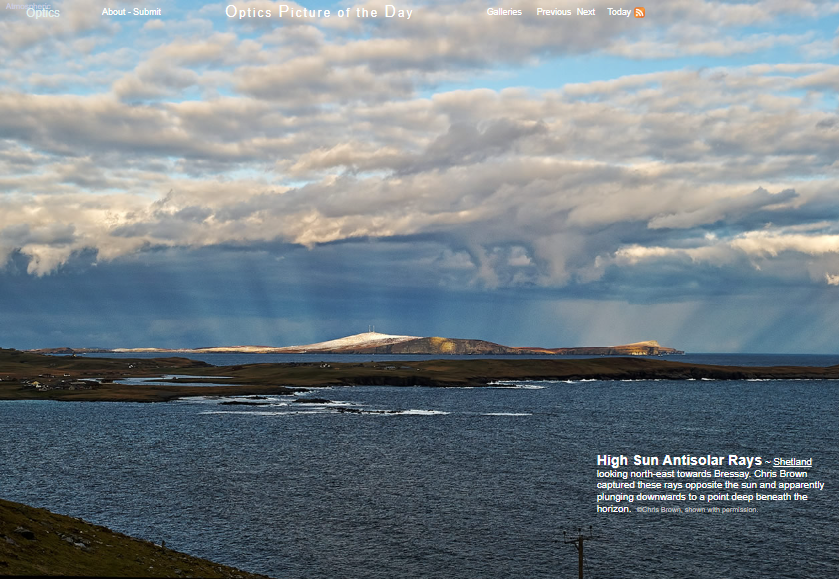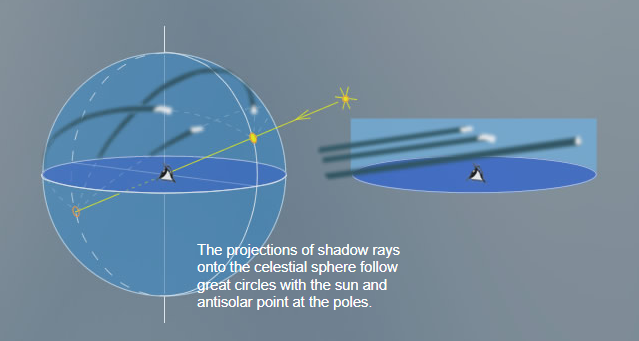OPOD - High Sun Antisolar Rays
OPOD - High Sun Antisolar Rays: A Fascinating Atmospheric Phenomenon
Have you ever noticed rays of light seemingly plunging downwards from the sky towards a point deep beneath the horizon? These captivating rays, known as high sun antisolar rays, can be observed opposite the sun and are a mesmerizing atmospheric optics phenomenon. While we are more accustomed to witnessing antisolar rays near sunset or sunrise, they can also be seen when the sun is high in the sky, albeit fainter, shorter, and of lower contrast.
Antisolar rays are usually formed by clouds near the sun casting long downward shadows across the sky. As a result of perspective, these parallel rays and shadows appear to converge towards the antisolar point, which is directly opposite the sun and always below the horizon. This convergence creates an awe-inspiring visual effect, as if the rays are reaching towards a mystical point deep within the Earth.
Interestingly, the projections of shadow rays onto the celestial sphere follow great circles, with the sun and antisolar point located at the poles. This means that the direction of these rays is determined by the positions of the sun and antisolar point in relation to the observer's location. The geometry of these rays creates a mesmerizing pattern that adds to their allure.
While high sun antisolar rays may not be as prominent as their counterparts observed during sunrise or sunset, they can still be witnessed under specific conditions. For instance, when you find yourself at sea or on a long beach, you may notice cloud shadows and rays visible all around the horizon even when the sun is at its zenith. Although fainter and shorter in length, these rays add a touch of enchantment to the daytime sky.
It is worth noting that this article has been automatically converted from an older version and may not appear exactly as intended. However, the essence of this captivating atmospheric phenomenon remains intact. To gain a deeper understanding of high sun antisolar rays, it is essential to observe them firsthand and marvel at the natural beauty they bring to the sky.
To summarize the key points about high sun antisolar rays:
- Antisolar rays are rays of light that appear to plunge downwards towards a point beneath the horizon.
- They are typically formed by clouds near the sun casting long downward shadows across the sky.
- These rays and shadows converge towards the antisolar point, which is directly opposite the sun and always below the horizon.
- The geometry of these rays follows great circles on the celestial sphere, with the sun and antisolar point located at the poles.
- High sun antisolar rays can be observed when the sun is at its zenith, although they are fainter, shorter, and of lower contrast.
- Cloud shadows and rays can be visible all around the horizon when the sun is high, creating a captivating visual display.
- The allure of high sun antisolar rays lies in their unique convergence and the mesmerizing patterns they create in the sky.
- Observing high sun antisolar rays firsthand allows for a deeper appreciation of their natural beauty and atmospheric optics.
- While the article may have undergone some conversion, the essence of this fascinating phenomenon remains unchanged.
- To truly experience the wonder of high sun antisolar rays, take a moment to look up and be amazed by the magic they bring to the daytime sky.

High Sun Antisolar Rays ~ Shetland looking north-east towards Bressay. Chris Brown captured these rays opposite the sun and apparently plunging downwards to a point deep beneath the horizon. ©Chris Brown, shown with permission.

The projections of shadow rays onto the celestial sphere follow great circles with the sun and antisolar point at the poles.
Antisolar or 'anti-crepuscular' rays are more familiar near sunset or sunrise. Then, as at left, they are usually formed by clouds near the sun casting long downward shadows right across the sky. The parallel rays and shadows appear, by perspective, to converge towards the antisolar point directly opposite the sun and therefore always below the horizon.
But antisolar rays can also be seen when the sun is high. They might be fainter, shorter and of low contrast but they are there. At sea or on a long beach cloud shadows and rays are often visible all the way around the horizon when the sun is high.
Note: this article has been automatically converted from the old site and may not appear as intended. You can find the original article here.
Reference Atmospheric Optics
If you use any of the definitions, information, or data presented on Atmospheric Optics, please copy the link or reference below to properly credit us as the reference source. Thank you!
-
<a href="https://atoptics.co.uk/blog/opod-high-sun-antisolar-rays/">OPOD - High Sun Antisolar Rays</a>
-
"OPOD - High Sun Antisolar Rays". Atmospheric Optics. Accessed on April 18, 2024. https://atoptics.co.uk/blog/opod-high-sun-antisolar-rays/.
-
"OPOD - High Sun Antisolar Rays". Atmospheric Optics, https://atoptics.co.uk/blog/opod-high-sun-antisolar-rays/. Accessed 18 April, 2024
-
OPOD - High Sun Antisolar Rays. Atmospheric Optics. Retrieved from https://atoptics.co.uk/blog/opod-high-sun-antisolar-rays/.